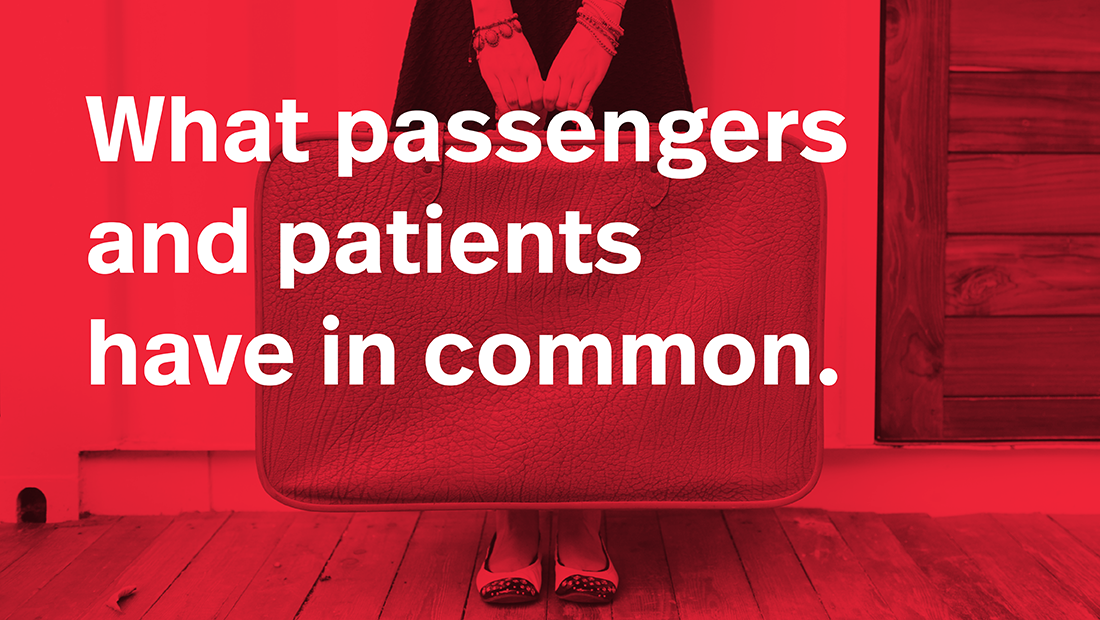Article
Innovating Patient-Centered Care: Lessons From the Mobility Industry

The high-capacity needs and a demand for improved quality of care in both the mobility and healthcare industry require that services become more customer-centred and focused on the complete experience. How does this impact mobility providers? They’ve had to turn towards a design thinking model and the use of technology to more effectively reach their goals.
However, despite healthcare providers constantly advocating “patient-centered care,” they’re still woefully behind when it comes to improving the access and layout of their services. In our experience in the mobility industry--working with clients such as Schiphol, ProRail/NS, Seamless Air Travel, Volkswagen--and our partnerships Helios, the Swiss Red Cross, and other agencies in the healthcare industry, we’ve been able to glean many insights after realizing passengers and patients really aren’t that different.
Just as travelers must trek through ticketing, baggage drop-offs and security screenings before finally arriving at their boarding gate, patients navigate a maze of office visits, laboratory tests and other healthcare services, imaging suites, and multiple procedures for comprehensive healthcare. By looking at the similarities, we can help healthcare providers discover new business models or services, culminating in improved overall patient satisfaction.
Like passengers, patients aren’t just individuals
In practice, people often share the traveling experience with others. It might be traveling with other family members, a significant other, colleagues or friends. This means you need to take into account all these different groups of travelers and when you're creating mobility services.
However, mobility services tend to help when it comes to easing common pain points. There are various initiatives available when traveling by airplane (think of airport apps with real time updates, wayfinding features, etc), allowing the traveler to make use of extensive tools to get a high-level overview of the entire customer journey. From the airport to other forms of transport to accommodation, there’s a great deal of data available for the passenger to make use of.
While the customer journey is similar for both passengers and patients, as mentioned above, we’ve noticed that, for patients, the emphasis is more on the process--as opposed to being focused on the patient’s experience.
Where to start?
Awareness has been set in motion by the new privacy rules (GDPR). This means there’s a demand for increasing openness: you must be transparent not only according the letter of the law, but also from the wants and desires of the consumer about which data you will use, as well as how long you’ll use it for. What you deliver must be in good proportion to what the customer will receive--a fair exchange. Providing digital services for passengers involves dealing with sensitive data. Patients have even more confidential data, going beyond passport information. When you ask passengers to give sensitive information, you’ll have to solve a problem not only within the confines of GDPR, but also in a frictionless way. Otherwise, it’s understandable that no one will consent to giving their data in the first place.
Conversely, the same goes for patients. In practice, however, more progress needs to be made in data sharing and data interoperability so that providers have real-time knowledge of workflows, care coordination and progress towards quality measures that can be incorporated into best practices. At the moment, there are various interesting initiatives in the aviation industry lobbying for a stripped-down digital identity revealing only the most relevant and necessary data per each moment identification is required (from passport control to check-ins to even hotel reception). So while privacy concerns may seem like a giant hurdle, they should in no way be seen as an impossible challenge to surmount.
What’s the next step?
Research shows passengers experience unnecessary levels of stress and anxiety while traveling; the same goes for patients when they take a healthcare journey. It’s not a stretch or leap to assume their fears and concerns might be even higher in the face of illness. Proper use of technology can help alleviate those feelings, but you should not focus on the possibilities of technology only: after all, not all of your target groups are digitally savvy.
Instead, think of the complete journey of the different groups and double down on making it as intuitive as possible. After all, if you implement a certain technology at one point, it will, whether for better or for worse, have an impact on other points in the journey. Another factor worth taking into consideration is that the use of new technology can potentially increase the stress or anxiety level. In the mobility industry there are basically 2 groups: high-tech (that is, those conversant with technology) vs. high touch (that is, those who need human assistance). With patients it’s not that different. Consider these differences, and with the help of service design thinking, you can move to focusing on a patient perspective, map the pain points of the process and see at what point in the journey you can help patients with new technology.
By centralizing patient needs and empathizing with their pain points, putting technology in context, and learning from other sectors, you have the golden key to unlocking business potential. From our extensive experience we’ve learned that a design-led process, in co-creation with users and stakeholders, generates faster and better results. Don’t jump the gun and indiscriminately spend your budget on implementation; instead, consider working with visualised concepts and functioning prototypes for invaluable insights and data. The benefits will be undeniable.
(The Dutch version of this article can be found here.)